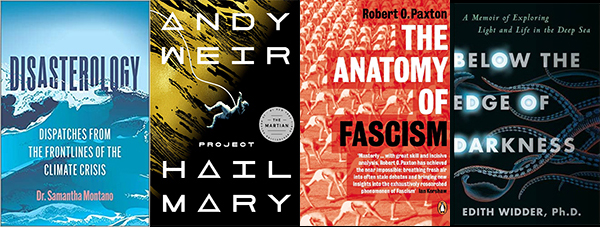A collection of book reviews that may be of interest to readers of this blog:
Set in Stone: the Geology and Landscapes of Scotland, by Alan McKirdy
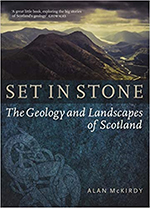 A well-illustrated introduction to the deep time history of Scotland’s landscape, controlled by the chain of myriad ancient happenings that produced and deformed rock of many kinds. Themes repeat, and there are one-off events that punctuate nature’s rhythms. The author has written for an audience of British non-specialists, but it would be a great place for an American professional geoscientist to start, to get an overview of Scotland’s geo-heritage. Having spent a month in Scotland several years ago, paying close attention to its geology, much of the book was review for me, but it did touch on several sites I missed – the Rhynie Chert, for instance. It would have been great for me to read before I went, but it was also a pleasant recap of the journey, complete with photographs of rock outcrops I recognize and think I know well. Scotland has such a deep, varied, and meaningful accumulation of rock types; If you’re not already a fan, this book will make you into one.
A well-illustrated introduction to the deep time history of Scotland’s landscape, controlled by the chain of myriad ancient happenings that produced and deformed rock of many kinds. Themes repeat, and there are one-off events that punctuate nature’s rhythms. The author has written for an audience of British non-specialists, but it would be a great place for an American professional geoscientist to start, to get an overview of Scotland’s geo-heritage. Having spent a month in Scotland several years ago, paying close attention to its geology, much of the book was review for me, but it did touch on several sites I missed – the Rhynie Chert, for instance. It would have been great for me to read before I went, but it was also a pleasant recap of the journey, complete with photographs of rock outcrops I recognize and think I know well. Scotland has such a deep, varied, and meaningful accumulation of rock types; If you’re not already a fan, this book will make you into one.
Passage, by Connie Willis
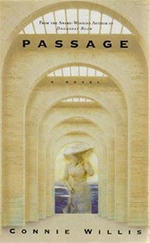 This novel, set in the 1990s, in a hospital in Colorado, examines what happens to the dying human brain when it experiences a “near death experience.” It’s an interesting premise, pursued in an interesting way, with multiple strands of plot coming together later in the story. However, it’s way too long. It’s at least 200 pages longer than I felt like it needed to be – 200 pages full of frenetic details which I suppose were offered to obscure and distract from key plot points – a school of red herrings, you might say – but I found it all quite tiresome to wade through. Honestly, I’m surprised I finished. That said, the early-’90s vibe is strong, with Blockbuster (the video store) and pagers (i.e. pre-cell phone remote communication devices) playing key roles: That part was an enjoyable foray into the world of my teenage years, but would doubtless limit the accessibility of the story for the younger generations. Willis paints a picture of the near death experience as a phenomenon that takes place entirely through biophysical means within the human brain, but gives treatment to both the sense that it’s more than that (that it transcends the physical world) is also explored both in terms of the internal qualitative experience but also its external promotion as proof of souls persisting independent of bodies after death.
This novel, set in the 1990s, in a hospital in Colorado, examines what happens to the dying human brain when it experiences a “near death experience.” It’s an interesting premise, pursued in an interesting way, with multiple strands of plot coming together later in the story. However, it’s way too long. It’s at least 200 pages longer than I felt like it needed to be – 200 pages full of frenetic details which I suppose were offered to obscure and distract from key plot points – a school of red herrings, you might say – but I found it all quite tiresome to wade through. Honestly, I’m surprised I finished. That said, the early-’90s vibe is strong, with Blockbuster (the video store) and pagers (i.e. pre-cell phone remote communication devices) playing key roles: That part was an enjoyable foray into the world of my teenage years, but would doubtless limit the accessibility of the story for the younger generations. Willis paints a picture of the near death experience as a phenomenon that takes place entirely through biophysical means within the human brain, but gives treatment to both the sense that it’s more than that (that it transcends the physical world) is also explored both in terms of the internal qualitative experience but also its external promotion as proof of souls persisting independent of bodies after death.
The Anatomy of Fascism, by Robert O. Paxton
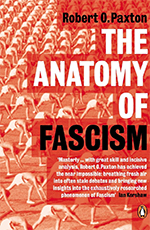 Well, here’s a book that I read not because I wanted to understand the past so much, but because I wanted to get a better grip on the present. A friend recommended it as the most methodical examination of the political/social phenomenon we call fascism; it’s written by a scholar at Columbia. As you might expect, Paxton explores Nazi Germany and the namesake movement in Italy headed by Mussolini, but there’s also a good amount of illumination gained by examining movements that didn’t quite make it to capturing any nation’s political system. Rather than a clear, punchy ideology-based definition of fascism, Paxton talks about aspects of fascist movements: characteristics and arcs of actions that tend to characterize them. Differences and exceptions prove these rules, and gradually a picture emerges of what it means to be fascist. It’s a process, triggered by trauma and stagnation, motivated by perceived emergencies, and aided and abetted by establishment conservative political actors. It nurtures a power structure which partially mimics official government responsibilities, and emphasizes violent punishment of “others.” Some countries go partway down the fascist path, but Germany and Italy are the only two examples that went all the way. A summary of the book’s way of recognizing fascism is (lifted from Wikipedia): “Fascism may be defined as a form of political behavior marked by obsessive preoccupation with community decline, humiliation, or victim-hood and by compensatory cults of unity, energy, and purity, in which a mass-based party of committed nationalist militants, working in uneasy but effective collaboration with traditional elites, abandons democratic liberties and pursues with redemptive violence and without ethical or legal restraints goals of internal cleansing and external expansion.” When I finished it, the question burning in my mind the whole time remained unanswered, so I googled it and yes, sure enough, with January 6th‘s attempted coup being the decisive event, Paxton is indeed convinced that Trump meets the criteria to be declared a fascist.
Well, here’s a book that I read not because I wanted to understand the past so much, but because I wanted to get a better grip on the present. A friend recommended it as the most methodical examination of the political/social phenomenon we call fascism; it’s written by a scholar at Columbia. As you might expect, Paxton explores Nazi Germany and the namesake movement in Italy headed by Mussolini, but there’s also a good amount of illumination gained by examining movements that didn’t quite make it to capturing any nation’s political system. Rather than a clear, punchy ideology-based definition of fascism, Paxton talks about aspects of fascist movements: characteristics and arcs of actions that tend to characterize them. Differences and exceptions prove these rules, and gradually a picture emerges of what it means to be fascist. It’s a process, triggered by trauma and stagnation, motivated by perceived emergencies, and aided and abetted by establishment conservative political actors. It nurtures a power structure which partially mimics official government responsibilities, and emphasizes violent punishment of “others.” Some countries go partway down the fascist path, but Germany and Italy are the only two examples that went all the way. A summary of the book’s way of recognizing fascism is (lifted from Wikipedia): “Fascism may be defined as a form of political behavior marked by obsessive preoccupation with community decline, humiliation, or victim-hood and by compensatory cults of unity, energy, and purity, in which a mass-based party of committed nationalist militants, working in uneasy but effective collaboration with traditional elites, abandons democratic liberties and pursues with redemptive violence and without ethical or legal restraints goals of internal cleansing and external expansion.” When I finished it, the question burning in my mind the whole time remained unanswered, so I googled it and yes, sure enough, with January 6th‘s attempted coup being the decisive event, Paxton is indeed convinced that Trump meets the criteria to be declared a fascist.
Below the Edge of Darkness: A Memoir of Exploring Light and Life in the Deep Sea, by Edith Widder
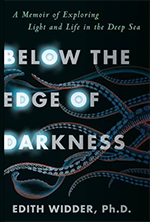 I remember Edie Widder’s talk to the Geological Society of Washington quite clearly: In discussing marine bioluminescence, she motivated interest by having all the lights in the auditorium extinguished, and then she brought out a bottle of seawater. When she gently shook it, dinoflagellates within pulsed boldly with blue-green light. It was magical. Widder has been pursuing various aspects of marine bioluminescence for her entire career, and this book is a very readable summary of her work. It begins with a moment of crisis in a submersible vessel, flashes back to an extreme health crisis in her youth, and then progresses through a career of adventure, scientific inquiry, and and the wonders of the deep dark sea. Widder’s main area of interest is the “midwater,” the largest portion of the ocean by volume, below the photic zone but above the bottom. It’s a place where most of the biology wants to feed at the surface (where phytoplankton capture energy each day), but find it too dangerous to actually be up there during the day, since predators can see them. So they feed at night, which necessitates a daily vertical migration between the nutrient-rich surface and the safe, inky midwater. It turns out that almost all of the critters use light as a defense, as headlights, as camouflage, or as a lure. She explores each of these uses with clever experiments, pushing the edge of what’s known about Earth’s largest biome. Really good: top notch, recommended.
I remember Edie Widder’s talk to the Geological Society of Washington quite clearly: In discussing marine bioluminescence, she motivated interest by having all the lights in the auditorium extinguished, and then she brought out a bottle of seawater. When she gently shook it, dinoflagellates within pulsed boldly with blue-green light. It was magical. Widder has been pursuing various aspects of marine bioluminescence for her entire career, and this book is a very readable summary of her work. It begins with a moment of crisis in a submersible vessel, flashes back to an extreme health crisis in her youth, and then progresses through a career of adventure, scientific inquiry, and and the wonders of the deep dark sea. Widder’s main area of interest is the “midwater,” the largest portion of the ocean by volume, below the photic zone but above the bottom. It’s a place where most of the biology wants to feed at the surface (where phytoplankton capture energy each day), but find it too dangerous to actually be up there during the day, since predators can see them. So they feed at night, which necessitates a daily vertical migration between the nutrient-rich surface and the safe, inky midwater. It turns out that almost all of the critters use light as a defense, as headlights, as camouflage, or as a lure. She explores each of these uses with clever experiments, pushing the edge of what’s known about Earth’s largest biome. Really good: top notch, recommended.
Project Hail Mary, by Andy Weir
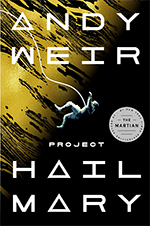 The author of breakout tour-de-force The Martian returns with his third novel. (The second was pretty weak: the moon thriller Artemis.) This one has a semi-silly initial premise, but after that, I think it’s quite good, pulling out the spirit of problem-solving from The Martian, and infusing the narrator with a similar sense of sarcasm and wry humor, but also mixing in a bit of the truly wondrous and weird. (“Weir(d),” see what I did there?) So, if you don’t want it spoiled, stop reading now. I’m going to reveal a key plot point that is unveiled in the first couple of chapters. [SPOILER ALERT] An astronomer discovers a strange line of light emanating from the sun, rising in an arc through space, and turning down again toward Venus. The sun begins to dim, and so a mission goes out to sample this strange line, discovering it is being emanated by a lifeform, a microbe. If you can suspend disbelief at this microbe going back and forth between the Sun and Venus, the rest of the novel is lots of fun. The protagonist of the novel, a high school science teacher, joins the effort to stop this microbe from eating our Sun and killing Earth. How? A survey of local stars reveals that they are all dimming too – all “infected” by what they soon call “astrophage.” Except one, Tau Ceti. If we can figure out what’s happening at that one, perhaps we can save Earth. So a mission is organized to go to Tau Ceti to suss it out and report back. This is the titular Project Hail Mary. But when the ship arrives, they find an alien race there doing exactly the same thing – trying to save their civilization, orbiting another of the dimming stars, 40 Eridani. First contact happens when two different planets are trying to figure out how to ward off extinction. Rather than a ‘war of the worlds,’ this leads to a fruitful collaboration, pairing scientific acumen from Earth with technological prowess from the aliens. [END SPOILERS] I really enjoyed it; and during some of the darkest days last semester, this book provided a digestible, delightful distraction. Lots of fun!
The author of breakout tour-de-force The Martian returns with his third novel. (The second was pretty weak: the moon thriller Artemis.) This one has a semi-silly initial premise, but after that, I think it’s quite good, pulling out the spirit of problem-solving from The Martian, and infusing the narrator with a similar sense of sarcasm and wry humor, but also mixing in a bit of the truly wondrous and weird. (“Weir(d),” see what I did there?) So, if you don’t want it spoiled, stop reading now. I’m going to reveal a key plot point that is unveiled in the first couple of chapters. [SPOILER ALERT] An astronomer discovers a strange line of light emanating from the sun, rising in an arc through space, and turning down again toward Venus. The sun begins to dim, and so a mission goes out to sample this strange line, discovering it is being emanated by a lifeform, a microbe. If you can suspend disbelief at this microbe going back and forth between the Sun and Venus, the rest of the novel is lots of fun. The protagonist of the novel, a high school science teacher, joins the effort to stop this microbe from eating our Sun and killing Earth. How? A survey of local stars reveals that they are all dimming too – all “infected” by what they soon call “astrophage.” Except one, Tau Ceti. If we can figure out what’s happening at that one, perhaps we can save Earth. So a mission is organized to go to Tau Ceti to suss it out and report back. This is the titular Project Hail Mary. But when the ship arrives, they find an alien race there doing exactly the same thing – trying to save their civilization, orbiting another of the dimming stars, 40 Eridani. First contact happens when two different planets are trying to figure out how to ward off extinction. Rather than a ‘war of the worlds,’ this leads to a fruitful collaboration, pairing scientific acumen from Earth with technological prowess from the aliens. [END SPOILERS] I really enjoyed it; and during some of the darkest days last semester, this book provided a digestible, delightful distraction. Lots of fun!
Disasterology: Dispatches from the Frontlines of the Climate Crisis, by Samantha Montano
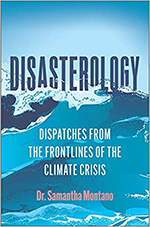 This is a book everyone should read. Samantha Montano has written a terrific, readable summary of how and why we study disasters, and what it means for human society. It applies geology, oceanography, and in particular climate science to the practical questions of how best to live our lives in a changing world. Significant attention is given to New Orleans and Houston and coastal Maine, but many other locations are detailed too: places that have seen powerful natural events cause destruction that costs lives and dollars. Montano’s own biography helps link these case studies together as she describes her personal growth and key insights via lessons learned in to the disasters of the first two decades of the 21st century. COVID-19 hit right as she was going to press, but I found it particularly depressing to see how the lessons emergency managers (“disasterologists”) have learned from events like Hurricane Katrina once again failed to be applied to the nascent global pandemic. Montano’s perspective is fresh, vital, and clear-minded. Reading it, I found myself wishing she were the head of the Federal Emergency Management Agency (FEMA). Recommended.
This is a book everyone should read. Samantha Montano has written a terrific, readable summary of how and why we study disasters, and what it means for human society. It applies geology, oceanography, and in particular climate science to the practical questions of how best to live our lives in a changing world. Significant attention is given to New Orleans and Houston and coastal Maine, but many other locations are detailed too: places that have seen powerful natural events cause destruction that costs lives and dollars. Montano’s own biography helps link these case studies together as she describes her personal growth and key insights via lessons learned in to the disasters of the first two decades of the 21st century. COVID-19 hit right as she was going to press, but I found it particularly depressing to see how the lessons emergency managers (“disasterologists”) have learned from events like Hurricane Katrina once again failed to be applied to the nascent global pandemic. Montano’s perspective is fresh, vital, and clear-minded. Reading it, I found myself wishing she were the head of the Federal Emergency Management Agency (FEMA). Recommended.

